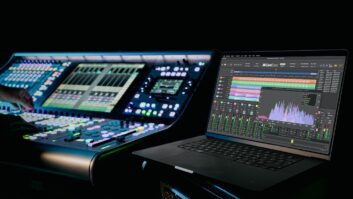There is a whole lotta action going on in the “live event space,” as marketeers are fond of calling it, I presume because in three simple words it covers a wide yet intermingled number of markets. To some it means corporate production, to others it’s houses of worship. There are courtrooms, boardrooms and classrooms, and there are Metreon shopping malls and outdoor plazas. Some work in stadiums and arenas and sheds, while others find their livelihood on a cruise ship or in the hotel and leisure industry. Technology development in the “live event space” is driven by facility designers, contractors, installers and system integrators. Thirty years ago, when the audio contribution consisted of ceiling speakers and automated mixers, it sure didn’t seem very sexy. Today, it’s where some of the most cutting-edge technologies are being created, and it’s where the jobs are.
advertisement
For many Mix readers, live event audio begins and ends with club and tour sound, or any public area where music is playing and you can stop, sit/stand and listen. That’s all part of the live event space, and there have been some amazing technology leaps in concert sound recently. Have you been out to hear music lately? Yes, the amps and speakers have improved dramatically, even in the past five years. And the level of control and processing at FOH seems nearly unlimited. But behind the scenes, the leaps in network control, interoperability and system performance have been equally impressive. And those technologies are going to advance rapidly in the coming years because they are tied into the larger live event space.
That rapid pace of change was in evidence at InfoComm 2013, just a few weeks ago in Orlando. It doesn’t seem that long ago that the aisles at a typical contract/install show were populated by smoke and confetti machines, tabletop displays of test gear and P.A.s in the parking lot. Today there are more aisles, and they’re teeming with 4k displays, streaming images, and compact control packages for audio, video, lighting and any type of graphic or media you could imagine. And on the audio side manufacturers are talking Dante and AVB integration while they show new mics and speakers and consoles.
Why the surge in technology development and subsequent rise in quality? It could be driven by “demand,” meaning people want to get out of their homes, and they want to be wowed when they do. Or it could be driven by “supply,” in that production and audio/visual technologies are finally reaping the benefits of the crazy technological leaps in the computer industry. It doesn’t matter. What matters is that the quality of our live entertainment experience just keeps getting better. The world may indeed be too noisy of a place, and we may be bombarded hourly by way too many images. But you have to admit, the quality has sure improved.
Creation, Connection, Control and Display. These are the fundamental elements of the live event space. The good news for Mix readers is that there is audio involved at nearly every point of the process. And that means jobs.
Tom Kenny
Editor
P.S. If you are within 1,000 miles of a stop on this summer’s Paul McCartney tour, go! Do what you have to, but go! I was one of the lucky 80,000 at Bonnaroo, and it’s as good as anything I’ve seen in my 50 years. I’m not exaggerating. The performance, the pacing, the energy, the songs! And it sounded fantastic, mixed by Paul (Pab) Boothroyd. Go!







